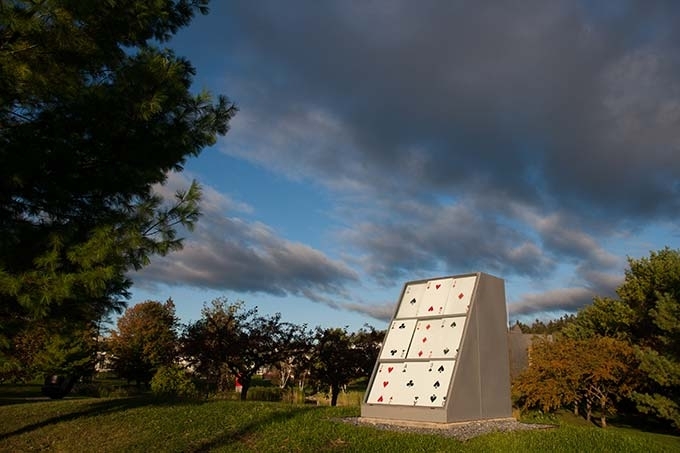Vito Acconci
Interactive, Text as Art, Three Dimensional, Utilitarian, Outdoor, South Campus, Concrete, Other, Steel

Vito Acconci (American, 1940–2017)
Way Station I (Study Chamber), 1983/rebuilt 2013
Concrete, painted steel, aluminum, and glass, 80 × 53 × 72 1/4 inches (closed)
Collection of Middlebury College Museum of Art, Vermont. Commissioned with funds provided by the Christian A. Johnson Memorial Art Acquisition Fund (1983) and the Committee on Art in Public Places with funds provided by the Middlebury College Board of Trustees One Percent for Art Policy (2013), 2013.017. Copyright © Vito Acconci / Artists Rights Society (ARS), New York.
Location: Pond behind the Mahaney Arts Center
Vito Acconci, an artist and architect of global stature, began his career as a writer and performance artist. Much of his early installation work incorporated language directly into the experience of the viewer, and some of his performances set a high bar for the extremely provocative performance art of the years to follow. By the late 1970s his work was featured in numerous museums, and he had his first retrospective exhibit in 1980 at the Chicago Museum of Contemporary Art.
In January 1983 Acconci was appointed a Christian A. Johnson Visiting Artist at Middlebury for Winter Term. A month later he completed Way Station I, a large metal shed with a single entry way and a six by four-and-one-half foot foundation. The structure included painted images of flags of various national entities—the United States, the Soviet Union, China, Cuba, and the Palestine Liberation Organization—as well as mirrored glass and painted two-sided sliding metal panels. On the inside of the structure the panels spelled “GOD.” “MAN,” and “DOG”; on the exterior they depicted playing cards.
Way Station I was originally installed at a site between dormitories and dining halls, along a pathway regularly traveled by many students. Now the area is bounded by the Ross Complex, McCardell Bicentennial Hall, and the Freeman International Center. The piece was intentionally sited in the vicinity of the College Observatory and oriented to take advantage of the view of the Adirondack Mountains to the west and the Green Mountains to the east. It was intended to provide its users both a study space and a place for rest, contemplation, and reflection.
Though intended to invite introspection, Acconci’s sculpture did just the opposite, inciting contention and abuse from much of the campus. Students and faculty alike complained about its plain metallic appearance and its placement on campus. Debates and arguments about the sculpture’s artistic merits occurred regularly in the Middlebury Campus from the moment it was constructed. In addition to verbal abuse, the structure also sustained regular physical abuse on the way to its ultimate demise in May 1985, when an unidentified vandal or group of vandals lit the sculpture ablaze.
Initially, although there was some public mention of its reappearance, few advocated for repair of the work. But after more than three decades in storage the sculpture—at the behest of Richard Saunders, director of the museum and chair of CAPP—has now been reinstalled, with some modifications.
Way Station I was Acconci’s first permanent site-specific work and, retrospectively, it clearly marks a significant transition from his temporary installations to his permanent architectural work. In conjunction with the reinstallation of Way Station I the museum also showed a retrospective exhibit titled Vito Acconci Thinking Space, which included photos and information about several of Acconci’s completed projects as well as reproductions of Middlebury Campus articles covering the controversy the work created.
